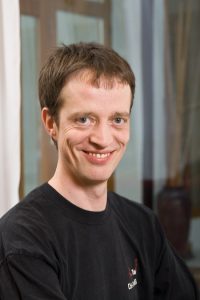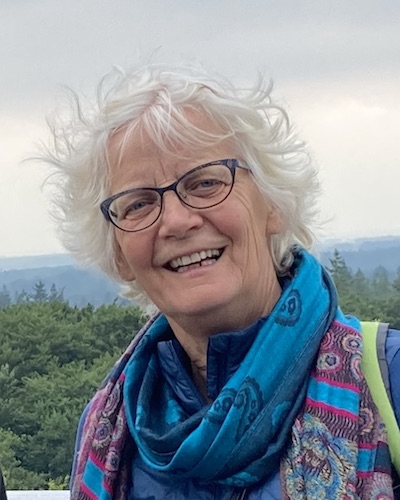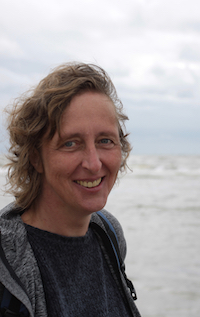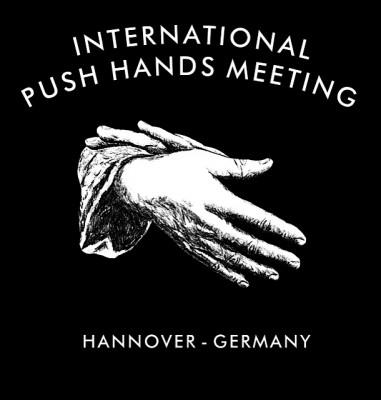Birgit Golze

Birgit Golze has been practicing Taijiquan for over 20 years. For 13 years, she has been teaching Taijiquan and partner exercises in her native city Dassel. Birgit discovered her passion for Push Hands during her teacher training with Master Nils Klug. Since this time, her own teaching of the form is closely linked to partner work.
Birgit’s passion for Push Hands has led her to meet national and international teachers both in Germany and internationally as well as on meetings all over Europe. Birgit also gathered valuable experience in competitions, always ranking among the first three places.
And last not least, Birgit has been a long standing member of the organizing team of the International Push Hands Meeting Hannover. It is save to say that over the years she has ”seen it all” – and she is happy to share her experience with you.
Nils Klug

Nils Klug has been learning Taijiquan since 1990. In 1993, he opened his first school. Over the years, he has taught at numerous Taijiquan meetings and has held workshops in Germany and abroad. To enable cross-style exchange in Taijiquan, Nils has been organizing the International Push Hands Meeting in Hannover since 2001. He also runs the website taiji-forum.com and its German sister-page. Both aim to promote Chinese internal arts and showcase the many ways in which Taijiquan, Qigong and other Chinese internal arts are taught and practiced worldwide.
Nils is a student of Grandmaster William C. C. Chen (New York) and is authorized by him to teach his Taijiquan. Grandmaster Chen, who has been teaching Taijiquan for over sixty years, was a student of Professor Cheng Man Ching, as well as Nils’ second teacher Dr. Tao Ping Siang (Taiwan, †2006) who also has had a major influence on his understanding of Taijiquan and Push Hands.
Continuous beginners’ program
*Our bilingual workshop for Push Hands beginners follows a coordinated schedule with matching topics. It is led by Birgit Golze (Wednesday-Friday) and Nils Klug (Saturday/Sunday).
Wednesday – Friday (Birgit Golze)
I often jokingly refer to Pushing Hands as the best therapy for relationship issues – especially because you learn to listen to your partner. Listening, understanding and the free play between the partners will therefore be the main focus of the first three days.
Wednesday – Listening
In this workshop, we want to lay the base for our communication: we practice to listen, to feel and to go along with the flow.
With only a few but intensive exercises, we will make our first contact with push hands and focus on taking notice of our partner in free partner exercises.
Due to this soft beginning, this workshop is also suitable for anyone that does not want to start the meeting by immediately going “all in” on the first day.
Thursday – Understanding
The second day will focus on the communication between two partners: What does my partner say to me? – and: What do I tell him*her? Where is it going?, or: Where do I want to go? We will experiment with some ideas that we may use in free push hands in the afternoon.
Friday – Playing
The third day centers around the play between two partners. Working with exercises that provide us with the necessary safety, we practice to be a good partner as well as trusting our partner, to listen, to feel, to push – and, if all develops nicely – to communicate freely with our counterpart.
Saturday / Sunday (Nils Klug)
Our ability to protect ourselves and our skills to prevent conflicts should work hand in hand in order to make a conversation a good experience for both partners. To reach this goal, clarity in our actions is necessary. Day 4 and 5 are dedicated to self-protection and clear statements.
Saturday – Protecting ourselves
When our wordless communication gets less regulated and more spontaneous due to our growing experience, it is worthwhile to take a step back and take our self-protection into account.
Today’s topic is how to protect our own space and to stand our ground. We will work on expanding – or differently put: we learn to react spontaneously to unexpected actions of our partner without collapsing.
Sunday – Expressing ourselves
A discussion can also become strenuous: Our counterpart oversteps our boundaries or does not listen properly? – In this case, it may be time to make our own standpoint (overly) clear.
On the last day, we will practice to express ourselves clearly and firmly in the face of our partner. We take our partners as we find them – giving a clear signal at the same time: this far and no further.
Anny Ploegmakers

Anny Ploegmakers practices Taiji since 1992. She started in Yang-stile with the traditional 37 short form and the sword form from Master Cheng Man-ch’ing (CMC).
Since 2000 she practices the 37 short form and sword form from Master Huang Sheng Shyan, student of CMC, besides the Refined Form, Spear and White Crane.
Anny passed her instructors exam from the Taijiquan School of Central Equilibrium of Wee Kee Jin (WKJ), in Mai 2016.
Teachers
Up from 1992 Epi van der Pol (NL), from 2000 Rob and Erich Völke (NL).
Since 1998 student of Wee Kee Jin, Auckland, N.Z. Anny attends the yearly workshops in the Netherlands and attended six residentials in Auckland.
Other teachers: Paul Renall (CZ), former student of WKJ, Serge Dreyer (F), Fernando Chedel and
others.
Teaching experience
Since 2002, Anny has been teaching classes in Utrecht, Groenekan, at the University of Applied Science Amsterdam (HVA) and at (international) workshops.
She is also a judge in form competitions in the Netherlands and Germany.
Theme
IN CONTACT – The power of relaxation
In order to push in the taiji way, it is required to be in contact with yourself and your opponent.
This workshop is about how to get and stay in contact with yourself while practicing pushing hands (PH).
We work on awareness, relaxation and sinking in contact with yourself and your PH-partner.
What are we going to do?
We start with wakening up the body, then relaxing exercises to enlarge your awareness about where in our body we are (or aren’t) relaxed and how to enlarge our relaxation.
We continue with exercises on how to integrate “contact with yourself” and “relaxation” in our form. Subsequently, we will do some partner work about how to integrate “contact with yourself” and “relaxation” in PH.
Participation requirements
No special requirements.
This workshop is suitable for beginners and advanced practitioners.
Mauro Bertoli

Mauro Bertoli started his martial education as a child by studying Judo and Karate, then he moved on to practice Chinese Kung Fu external styles.
In 1987, he started to practice Yang style Taijiquan with Master Chang Tsu Yao.
Following the death of his Master, he began with a long course of study, continuously working with various authoritative exponents of Chinese interior styles, while continuing to deepen the system practiced.
Mauro also started teaching in this period, experimenting with various forms of didactic approach.
In 2001, he made a long study trip to China, practicing with many masters.
In 2013, together with a group of qualified teachers and friends, he founded ARTY, an association that aims to continue research and experimentation within various martial sectors, becoming its president.
Teaching Experience
Mauro participated as a teacher in the 2015/2017/2019 editions of the “Tai Chi Tcho” meeting in La Chaux-de-Fonds (CH) with hundreds of practitioners from all over Europe.
He also participated in 2017 as a teacher at the 6th International Push Hands Meeting in Prague (CZ).
Mauro has thirty years of teaching experience, especially in Yang style Taijiquan, Taiji Sword, Qigong and TuiShou (Push Hands) gained by holding courses and seminars in Italy and in Europe.
Theme
Pushing hands and internal work: postures and continuity
The workshops will be divided into two parts:
In the first, shorter and introductory part, we will work on static positions to prepare for pushing hands. It is an “internal work” (Neijia) specific for practitioners of pushing hands, in which we aim to isolate the sensations and the physical and mental attitude, giving ourselves the time to act on tensions and release. These exercises are particularly useful for improving our posture and our general approach.
In the second part, we will work on connecting some of the most common postures present in the Yang style of Tai Ji Quan and the practice of pushing hands. We will work on one posture per day. – Without focusing on the differences in interpretations between schools, we are looking for continuity between the work of the forms and pushing hands.
Special participation requirements
None. The workshops will be accessible to all levels and especially suitable for beginners.
Maike Duarte de Oliveira
Maike Duarte de Oliveira has been practicing Yang Style Tai Chi for over 30 years. Among her teachers are Michael Dackau, Christel Proksch and Daniel Grolle as well as Wilhelm Mertens for the last 15 years. She took part in the Tai Chi-teacher training of the last named and also practices Qigong with him. She has been training with Saar Avivi and Paul Silfverstrale for three years, which gave her an insight into Wudang Practical Tai Chi Chuan.
Theme

Situations and possibilities – Expand your Push Hands toolbox!
I love push hands as a non-verbal communication during which I get to know and to understand myself and my partner.
Competition and wrestling around is also fun. In these cases we try to create a situation which serves our own goals to end the interaction as fast as possible with our victory.
In Push Hands, I want to interact with my partner without self-interest, trying to listen, to understand what is happening, to be able to shape the situation. Therefore, it is of particular interest to experience which range of possibilities a given situation offers and which necessities it entails, so that I can differentiate my (re)actions.
In Push Hands, we often experience recurring situations, in which we only manage to save us with a more or less powerful push or in which end up being pushed around without really understanding, what happened, let alone how we could have reacted differently.
In my workshop, I would like to create a space with a secure setting where we can experience these kind of situations to understand them, to discover possibilities to shape them differently, so that we will be able to answer with a range of options. – The aim is not to only use one crude instrument, but to be able to switch the big pipe wrench with flat pliers, pincers, round-nosed pliers – or even only a little oil.
On our first day, we will start from the Peng-(expanding) quality. On Sunday, we will probably add some Lü(Pulling)-situations after some repetition and reflexion, following the development of the workshop situation.
